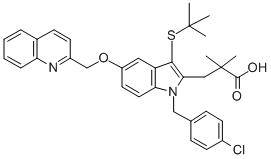136668-42-3
 136668-42-3 結(jié)構(gòu)式
136668-42-3 結(jié)構(gòu)式
基本信息
L-686708
Quiflapon
MK 591(Quiflapon)
MK-0591 (Quiflapon)
QUIFLAPON
MK-591
L-686708
QUIFLAPON
MK0591
MK 0591
3-(3-(tert-Butylthio)-1-(4-chlorobenzyl)-5-(quinolin-2-ylmethoxy)-1H-indol-2-yl)-2,2-dimethylp
3-(3-(tert-butylthio)-1-(4-chlorobenzyl)-5-(quinolin-2-ylMethoxy)-1H-indol-2-yl)-2,2-diMethylpropanoic acid
3-[3-tert-butylsulfanyl-1-[(4-chlorophenyl)methyl]-5-(quinolin-2-ylmethoxy)indol-2-yl]-2,2-dimethylpropanoicaci
物理化學(xué)性質(zhì)
常見問題列表
IC50: 1.6 nM (FLAP).
Quiflapon is a potent inhibitor of leukotriene (LT) biosynthesis in intact human and elicited rat polymorphonuclear leukocytes (PMNLs) (IC 50 values 3.1 and 6.1 nM, respectively) and in human, squirrel monkey, and rat whole blood (IC 50 values 510, 69, and 9 nM, respectively). Quiflapon has no effect on rat 5-lipoxygenase. Quiflapon has a high affinity for 5-lipoxygenase activating protein (FLAP) as evidenced by an IC 50 value of 1.6 nM in a FLAP binding assay and inhibition of the photoaffinity labelling of FLAP by two different photoaffinity ligands. Inhibition of activation of 5-lipoxygenase was shown through inhibition of the translocation of the enzyme from the cytosol to the membrane in human PMNLs.
Quiflapon is a potent inhibitor of LT biosynthesis in vivo, first, following ex vivo challenge of blood obtained from treated rats and squirrel monkeys, second, in a rat pleurisy model, and, third, as monitored by inhibition of the urinary excretion of LTE4 in antigen-challenged allergic sheep. Inhibition of antigen-induced bronchoconstriction by Quiflapon is observed in inbred rats pretreated with methysergide, Ascaris-challenged squirrel monkeys, and Ascaris-challenged sheep (early and late phase response) [1]. Pups were treated with either vehicle or Quiflapon 10, 20, or 40 mg/kg subcutaneously daily for days 1-4, 5-9, or 10-14. On day 14, the lungs were inflated, fixed, and stained for histopathological and morphometric analyses. Hyperoxia groups treated with Quiflapon untreated hyperoxia groups showed definite evidence of aberrant alveolarization but no inflammation.
